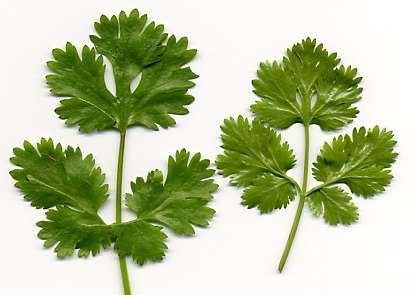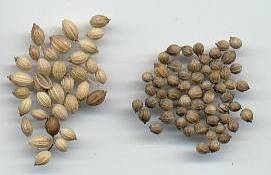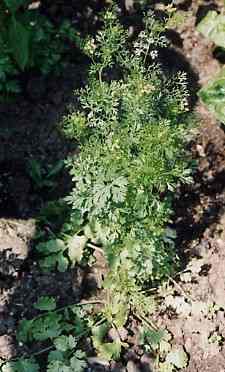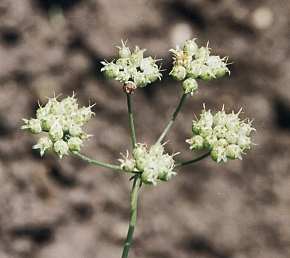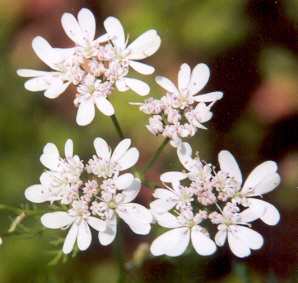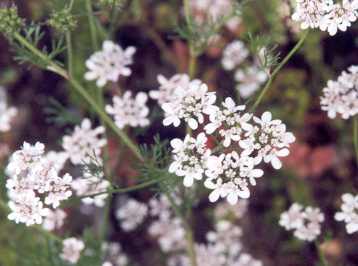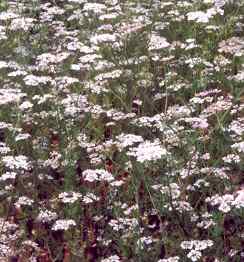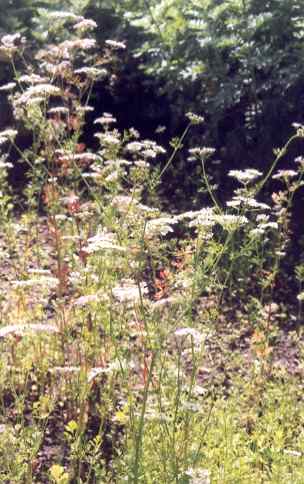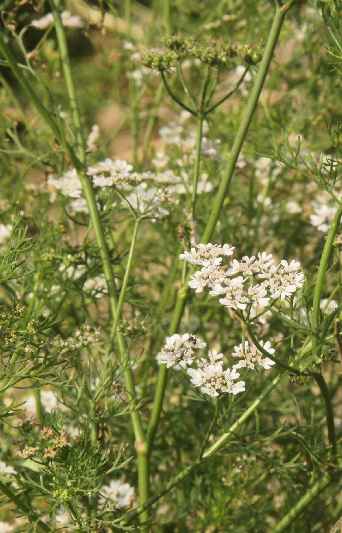
|
| Coriander field |
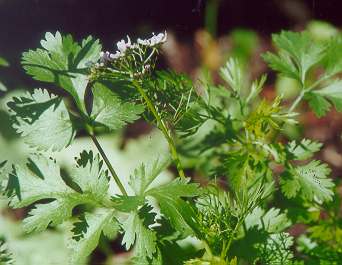
|
| Coriander (flowering plant) |
Coriander is an essential part of curry powder (see curry leaves) and and is contained in most Indian spice blends, e. g. North Indian (garam masala [गरम मसाला, گرم مسالحہ oder گرم مصالحہ]. Also Ethiopian berbere [በርበሬ], which much resembles Indian spice mixtures, contains coriander fruits (see long pepper). Lastly, it should be noted that also Latin American cuisine makes much use of them. Roasting or frying, much practiced in India and Sri Lanka, enhances the flavour.
South Indian cuisine has a particular affinity to coriander fruits, which are usually toasted to a very dark colour.
Coriander is the main component in the spice mixture
sambar podi [சாம்பார் பொடி],
which appears to originate in Tamil Nadu, but is now common to all the Southern States; it is used to flavour a
typical South Indian vegetable curry
(saambaar [சாம்பார்])
made from lentiles or other pulses and various vegetables; it has a rather thin, soupy appearance.
Sambar is oftn eaten with a thin, crèpe-like bread made from ground rice
(dosai [தோசை])
or, particularly at breakfast time, with idli [இட்லி],
steamed dumplings from a slightly fermented rice and bean batter.
Base component of sambar podi are
lentils or tiny beans (urad dal [उड़द दाल]), which are dry-roasted or
toasted until they lose their raw flavour. They are mixed with other toasted
spices (mostly coriander, cumin, fenugreek and chiles)
and black pepper; optional ingredients are toasted
mustard seeds and asafetida powder. The powder is simply added, together
with fresh curry leaves, to boiling lentil or
vegetable curries.
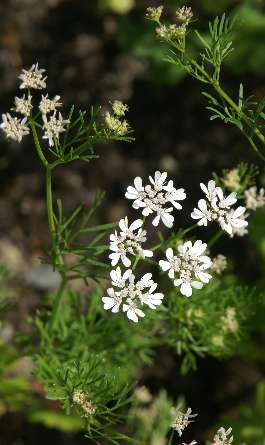
|
| Coriander flower and leaves |
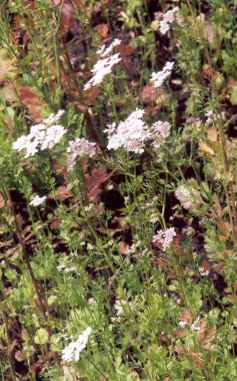
|
| Coriander plants |
The usage of toasted legumes is typical for South Indian cuisine. For another example of a Southern Indian spice mixture (bisi bele pudi [ಬಿಸಿ ಬೇಳೆ ಪುಡಿ]), see coconut. Spice mixtures similar to sambar podi are also much in use among the descendants of South Indian immigrants in Malaysia or Singapore. In parts of South India (particularly Andhra Pradesh and Karnataka), a powder of toasted and ground legumes is used as a table condiment, possibly augmented with other spices. Outside of the South Indian sphere of influence, I found a similar powder in Manipur (see chameleon plant).
Arabic cooking makes much use of coriander fruits, which are contained in a number of Oriental spice blends, like Moroccan ras al-hanout (see cubeb pepper) and baharat from the Gulf states (see paprika); they are also part of Ethiopian berbere (see long pepper). Coriander has a unique ability to fuse and amalagamate different aromas in a spice blend, and this property nicely explains why coriander is often found in spice mixtures even in regions where pure coriander is not so popular.
Coriander leaves (also called coriander green) are popular over the most part
of Asia, beginning in Western Asia (Caucasus region, particularly herb-loving Georgia, and also Yemen)
and stretches all the way to India and China, albeit in low intensity. Both in India and China,
coriander leaf usage shows regional patters with some hot spots
, e. g.
in Maharashtra and Hunan; on the other side, their characteristic flavour is avoided altogether in Sri Lanka.
Also Japan is a coriander-liberated zone.
Coriander leaf usage peaks in South East Asia; where it is indespensable for some cuisines. In Thai cooking, coriander leaves are often used to add additional flavour to soups (tom yam [ต้มยำ], see kaffir lime), salads (laab [ลาบ], see peppermint) and curries; for green curry paste (prik gaeng kiau [พริกแกงเขียว]), both root and leaves are needed for colour and heat-stable flavour (see coconut). The heartland of coriander leaf usage in South East Asia, however, is Vietnam. Particularly in South Vietnam, chopped coriander leaves appear as decorations on nearly every dish, be it soup, noodles or even the French-introduced baguettes. Often, foods are served with a rich herb garnish that contains, besides crisp but tasteless lettuce leaves, various herbs (coriander, basil, peppermint, Vietnamese coriander and more). Coriander leaves are less enjoyed in Malaysia and Indonesia.
Coriander leaves resemble European parsley leaves
in a number of ways: They have similar shape and are both best used raw,
as the flavour vanishes after prolonged cooking. Few recipes boil either of these herbs,
but there is again the coincidence the parsley is often used in European broth recipes,
usually in the form of bouquet garni, and this finds a sibling in the
South Indian spice broth rasam [ரசம்],
where coriander leaves are boiled (see tamarinde for more).
In both plants, the root has a similar flavour than the leaves, and its flavour turns out to tolerate
boiling or simmering much better.
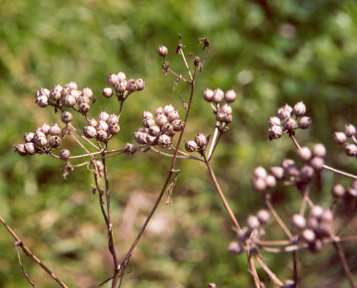
|
| Ripe coriander fruits |
Coriander leaves, however, are a rare ingredient in the cooking of Western Asia; the main example is Zhoug (or zhug [زوق]), a spicy paste typical for Yemeni cookery, which sometimes also contains coriander fruits. The key ingredients are green chiles, garlic, cardamom and black pepper. Further, optional ingredients are cumin, lemon juice and olive oil. Several recipes name caraway as an ingredient, but I am not sure that this is not a translation error for cumin. All components are processed to a thick paste. Zhoug may be used as a relish, bread dip or condiment. A version of zhoug prepared with red chiles is known as shatta [شطة], which is also an Arabic name of red chiles.
The only other Western Asian cuisine using green coriander is Georgian cooking.
Rather uniquely, Georgians like to combine parsley
and coriander leaves do decorate their stews, or serve both types of leaves
together as a fresh contrast to cheese. Often, the green power of these two
herbs is augmented by dill leaves. In Georgia,
cooks use not only the leaves but also the umbels with immature fruits, which have
a particularly intesive flavour. In neighbouring Azərbaycan (Azerbaijan),
green coriander leaves are less used, and in other countries of the region they are almost unknown.
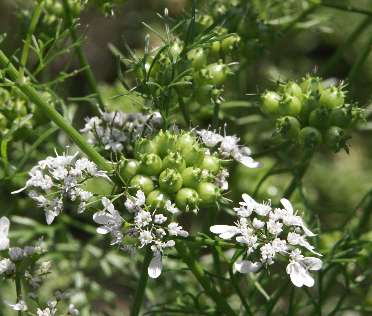
|
| Intertwined coriander umbels with flowers and unripe fruits |
Use of coriander leaves is very frequent in Latin America, especially México (e. g., in salsa, see long coriander, or ceviche, see lime). Another famous Mexican food relying on coriander leaves is guacamole, a spicy coarse mash from avocados, chopped tomatoes, lime juice, onions, garlic, chiles and coriander leaves. For the heat, Mexicans most often use the green jalapeño or the slightly hotter serrano (see also paprika), but actually I prefer the flavourful habanero or related chiles for that food.
The Mexican herb epazote is sometimes substituted by cilantro leaves, especially outside México; but the two plants have little in common, and I think that savory or thyme might be better suited.
Coriander leaves are most often used raw; cooking or even short frying tends to diminish their fragrance. As always, there are exceptions to that rule: In some Indian and Central Asian recipes, coriander leaves are used in huge amounts and long-cooked till they dissolve and their flavour mellows. An example is the Iranian herb sauce ghorme, see fenugreek.
Being confronted with coriander leaves for the first time, many people from Europe or Northern America find their taste repulsive. This may change after some time of forced exposure to this herb; after two months in Vietnam, I found myself unable to enjoy noodle soups (pho [phở], see Vietnamese cinnamon on Northern Vietnamese and Vietnamese coriander on Southern Vietnamese noodle soups, respectively) without coriander leaves, although I pretty much had disliked the taste when I had entered the country. Today, I shouldn’t even dream of preparing Vietnamese soups without first finding a supply of coriander green; I have, however, noticed that my guest usually have not yet reached the necessary degree of mastership over their own taste buds and, thus, prefer their soup bowls without coriander leaves.
Yet, even in Europe, the popularity of coriander leaves has increased steeply
in the last years of the late millennium (in the USA, a similar development
had taken place a decade earlier). Due to the increasing interest in ethnic
cookery, and the success of Mexican and Thai restaurants, coriander leaves are
now more appreciated in Europe than ever before. In conjunction with the changing eating
habits, new recipes are published that make heavy use of formerly hardly-known
herbs, coriander being one of them. See also rocket
about zeitgeist cooking
.
